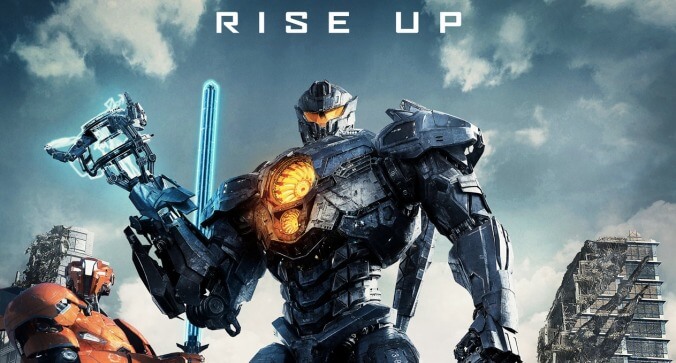Guillermo Del Toro’s Pacific Rim was, if nothing else, a true kitbasher’s movie, Gundam meets Godzilla with a side of the director’s love of icky sea life, but its sequel is geek lite, an impersonal gloss on the first film’s framework of nerdy pleasures. The basics: In the near future, humongous aliens (called kaiju, like the giant monsters of Japanese film) lumber out of a dimensional fissure deep in the Pacific to wreck our cities. To fight them, humanity builds Jaegers, 250-foot-tall robots piloted via neural uplink. The catch is that the Jaegers’ technical complexity and colossal size requires something like a dual-processor setup, two pilots’ brains working in tandem in what’s called a “drift.” This idea, a goldmine of interpersonal and soap-operatic potential, is under-explored in the original film and barely explored at all in Pacific Rim: Uprising.
Directed and co-written by Steven S. DeKnight, the creator of Starz’ Spartacus, Uprising centers on Jake Pentecost (John Boyega), the son of Stacker Pentecost, the throaty Jaeger commander played by Idris Elba in the first film. Here, one is obliged to point out that there is no way in hell a man named Stacker Pentecost would settle for naming his kid “Jake.” The characters in Pacific Rim had names like Rocky boxers: Hannibal Chau, Hercules Hansen, Mako Mori, Raleigh Becket, etc. There was a Russian pilot duo named Kaidanovsky, like the Soviet actor who played the title role in Stalker. In Uprising, the hero is named Jake and his co-pilot buddy is named Nate. The only good thing about Nate is that he’s played by Scott Eastwood, whose uncanny vocal and facial resemblance to a younger version of his old man, Clint, qualifies as a welcome presence in a movie like this one. When all else fails, one can at least pretend they’re watching Clint Eastwood give a shit about robots.
Not that the robots are much to look at. Del Toro’s Jaegers were crushingly heavy machines, descendants of the crane and excavator with supernumerary limbs or bodies like buckets. Uprising, which credits Del Toro as producer and visual consultant, updates them into sleek post-Transformers Bay-hemoths. One has a hand like a metallic Bloomin’ Onion® of Outback Steakhouse fame.
Set a decade after the events of the original film and the apparent defeat of the kaiju, Uprising wastes no time introducing a post-kaiju world, only to disregard most of its intriguing ideas later on. Having ditched the international Jaeger armed forces, the Pan Pacific Defense Corps, Jake Pentecost lives the high life in the ruins of Los Angeles, trading looted Oscars for food and scavenging Jaeger spare parts for the black market. In a sequence that harks back to the 1980s school of sci-fi production design, when bleak futures were mostly made up of abandoned steel works and duct hosing, he crosses paths with Amara (Cailee Spaeny), a teenager who’s managed to built her own armadilloid mecha from scrap. The two end up getting arrested together. Rinko Kikuchi’s character from the original film, Mako Mori, offers Jake a way out of prison, as long as he reenlists in the PPDC, joins Nate as co-instructor at the awesomely named Moyulan Shatterdome, and brings along Amara as a cadet.
Of course, the threat of the kaiju (actually the bioengineered shock troops of an extra-dimensional race called the Precursors) is far from gone. But the towering monsters take their time making a return, so DeKnight instead focuses on introducing disposable new characters and reintroducing old ones—including the quirky scientists Newton Geiszler (Charlie Day) and Hermann Gottlieb (Burn Gorman)—while doing his impression of James Cameron’s futuristic militaria, with all of the requisite dopey dialogue, but little of the style. Independence Day: Resurgence, a lackluster sequel to a disaster film to which the first Pacific Rim owed a sizable debt, at least recognized the dystopian qualities of a post-invasion society built on hero cults and military preparedness. Uprising takes it at face value.
Simply put, it lacks its predecessor’s curiosity about its world—its fascination with colorful backdrops and machines. The weightless combat (always in daytime, for some reason) has a serious Super Sentai or Power Rangers vibe, underscored by the fact that this film, unlike the original, has a villain, who watches the climactic Tokyo showdown from a rooftop, cackling like Rita Repulsa. Del Toro’s movie, while far from the director’s best, had an idealistic vision for its anime-influenced hobby-store pursuits: a diverse, eclectic Earth united in the awesomeness of giant robots and giant monsters. Pacific Rim: Uprising offers only its spare parts.






















![Rob Reiner's son booked for murder amid homicide investigation [Updated]](https://img.pastemagazine.com/wp-content/avuploads/2025/12/15131025/MixCollage-15-Dec-2025-01-10-PM-9121.jpg)


















